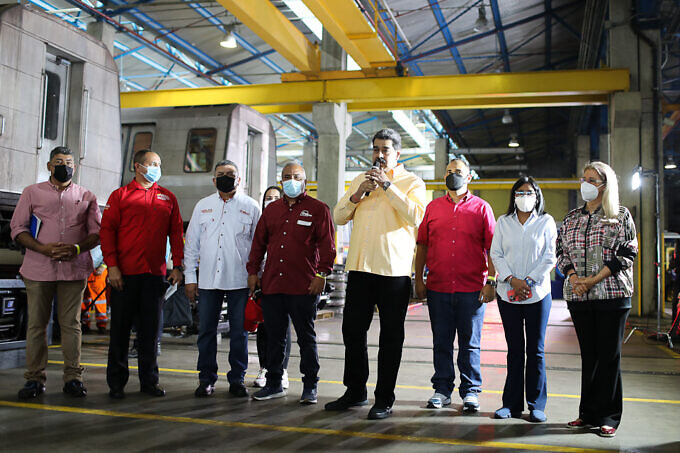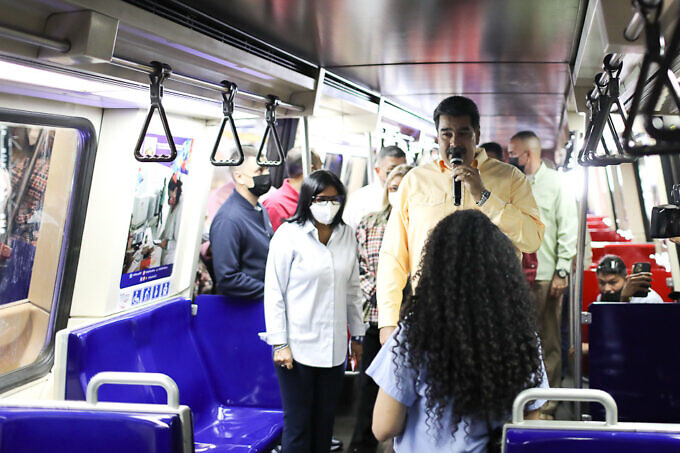
President Maduro launches a comprehensive plan for the recovery of the Caracas Metro, at an event in the workshops of the Caracas Metro. Photo: Presidential Press.

Orinoco Tribune – News and opinion pieces about Venezuela and beyond
From Venezuela and made by Venezuelan Chavistas

President Maduro launches a comprehensive plan for the recovery of the Caracas Metro, at an event in the workshops of the Caracas Metro. Photo: Presidential Press.
On Thursday, September 1, the president of Venezuela, Nicolás Maduro, announced a plan for the rehabilitation of the Caracas Metro. He approved $150 million for the comprehensive recovery of the entire system and an additional $16 million for renovation of the rails. Moreover, he assigned several institutions to be in charge of the maintenance of several important stations, such as Petare, Palo Verde, Plaza Venezuela, Capitolio, and La Rinconada. A security plan has been created for this. User committees will also be created.
“Today starts a special plan to make the Caracas Metro the best metro system in the world, and we are going to achieve it. The Metro moves with you!” said the Venezuelan president during an event in the workshops of the Caracas Metro in Las Adjuntas.
President Maduro also approved the creation of a National Investment Fund for Transportation, with 30% of the proceeds from the tolls in the country.
The president, who worked in the Caracas Metro in his youth, highlighted the work of the employees of the system, who have kept it active despite the blockade and the sanctions, serving 2.8 million users daily. “The workers have been attacked, the workers are the ones who maintain the Metro system in spite of the sanctions, the financial persecution, the prohibition to buy spare parts abroad, the freezing of accounts,” he said.

President Maduro formally presented Juan Carlos Du Boulay as the new president of the Caracas Metro, who was appointed on August 18 through an announcement in the Official Gazette.
RELATED CONTENT: Venezuela Achieves New Record in Food Production in 2022
He also appointed Vice President Delcy Rodríguez as head of the project “The Metro moves with you.”
“We have done well when we have assumed direct responsibilities,” he said. “Vice President Delcy Rodríguez likes to take action, she likes this kind of work. For the special Metro plan that I am launching today, I appoint Delcy Rodríguez to be in charge of the plan and the workers.”
Comprehensive plan
Vice President Rodríguez stated that the recovery plan for the Caracas Metro is a comprehensive plan, which includes the recovery of the infrastructure, decoration, landscaping, the 100 works of art, the 48 stations belonging to the four lines, the Metrocable and the Cable Train, as well as the administrative offices and the workers’ rest areas, waterproofing, attention to leaks, elevators, escalators, and a special security plan.

President Maduro also announced that committees of users of the Caracas Metro will be created to support the workers and carry out maintenance and volunteer work, among others.
National Assembly Deputy Pedro Infante, accompanying the president, announced that this Saturday he and others will be present in the 69 stations of Metro, Metrocable, Cable Train and BusCaracas to create users’ committees and volunteer work schedules for the maintenance of the Metro. Nahum Fernández, chief of government of the Capital District, stated that in each station there will be alliances of community councils, user committees and social organizations.
RELATED CONTENT: Venezuela is Producing Magnesite For Its Own Consumption (Import Substitution)
Station-in-charges
President Maduro presented the heads of various institutions as “station-in-charges,” persons who will be in charge of the rehabilitation of important stations of the system.
Minister of Industries Hipólito Abreu, and Román Maniglia, President of Banco de Venezuela, were present in the Plaza Venezuela and Zona Rental stations, where they spoke about the works being carried out there, including improvements in lighting, general cleaning, waterproofing, air conditioning in offices and fumigation. President Maduro recalled that he, as a Caracas Metro worker, met his wife, Cilia Flores, at the Plaza Venezuela station. “They are going to make it very beautiful!” he said, referring to Abreu and Maniglia, who will be in charge of renovation of those stations. He also saw that the images of the roofs of the trains of Line 1 are quite worn out and requested them to take care of that.
Gustavo Vizcaino, president of SAIME (Administrative Service of Identification, Migration and Foreigners), in-charge of the Metro Capitolio station, said that he knows the place very well as he lived nearby and used the metro frequently. He announced that on Sunday the station was thoroughly checked, and it has been concluded that the floor covering, stairways, lights and window shutters will be repaired. One of the entrances has been closed for three years as the workers have pointed out. “We did a tour, and every door they opened surprised us because of the technology that the Metro has,” said Vizcaíno.
José Vicente Rangel Ávalos, mayor of Sucre municipality, showed the recovery and repair works being carried out in the Petare and Palo Verde stations. The Ezequiel Zamora Ecosocialist Corporation (CorpoEZ) is participating in this work.
Antonio Álvarez, president of the Instituto Nacional de Hipódromos y el Poliedro de Caracas, made a presentation from the La Rinconada station, of which he will be in charge, showing the work being done there.
The Banco del Tesoro informed on Twitter that it will sponsor the rehabilitaion of Chacao station.
Translation: Orinoco Tribune
OT/SC/AF

He is passionate about computer science since he was about 14 years old, at that age “a man gave me a small computer that he had bought in the eighties, of those that were connected to a television and had to be programmed to work (a Sinclair ZX81 ), and I really liked it.” On his political inclination, his parents were a great influence. “They were people of very humble origins, both emigrants, dissatisfied with injustice and inequality. But they were not militants of the left. I had many other influences, classmates in HS whose parents were on the left, as well as several teachers who were trained in the Pedagogical and gave us classes at a time as conflictive as it was the presidency of CAP and the military insurrection of Chávez ” He enrolled in the UCV and in 2006 he graduated in Computing, a career that he complements with popular communication in the digital field.